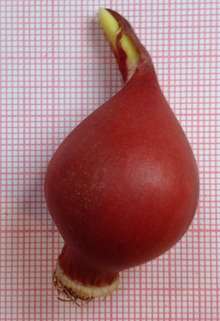Tulipa turkestanica
Tulipa turkestanica, the Turkestan tulip, is a species of tulip native to central Asia (Kyrgyzstan, Tajikistan, Uzbekistan, and Xinjiang).[1][2][3][4][5] It was first described by Eduard August von Regel in 1873 as a variety of T. sylvestris, then elevated to full species status two years later.[6][7]
| Turkestan tulip | |
|---|---|
 | |
| Scientific classification | |
| Kingdom: | Plantae |
| Clade: | Tracheophytes |
| Clade: | Angiosperms |
| Clade: | Monocots |
| Order: | Liliales |
| Family: | Liliaceae |
| Genus: | Tulipa |
| Subgenus: | Tulipa subg. Eriostemones |
| Species: | T. turkestanica |
| Binomial name | |
| Tulipa turkestanica | |
| Synonyms[1] | |
| |

Description
Tulipa turkestanica is a herbaceous, bulbous perennial growing 10 cm to 15 cm tall, with 2–4 thin glaucous leaves up to 15 cm long on each stem. The margins and tips have a pinkish colour. The leathery bulb is bright reddish-brown and has a hairy tunic. Each plant produces between one and twelve[8] star-shaped flowers, grouped in a raceme. The flowers are ivory white to pinkish red, with a yellow to orange basal blotch, which extends to about a third of the flower. The backs of the outer tepals are greyish red with a whitish fringe and much wider than the inner tepals, which have a thin, green line on the middle of their outside. The filaments are orange, and the anthers are dark violet or yellow with a violet tip,[9] which distinguishes it from T. biflora that has very similar flowers but yellow anthers. It is also slightly smaller and flowers slightly earlier. The flowers only open in direct sunlight. The smell is often described as unpleasant.[10] In the wild, it flowers between March and May, depending on the altitude.

Distribution
The Turkestan tulip is found in the Pamir Alai and Tien Shan; Kazakhstan, Kyrgyzstan, Uzbekistan, Turkestan, Iran and Dzungaria in Northwest China.[11] It grows on stony slopes, river margins and rocky ledges between 1800–2500 m asl.[12]
Cultivation and uses
Tulipa turkestanica is an ornamental plant often grown in rock gardens.[13] It needs full sun. In England, it flowers in the middle of March.[14] As other tulips of the Eriostemenes group, Tulipa turkestanica cannot be crossed with garden tulips.[15]
References
- Kew World Checklist of Selected Plant Families
- Merkodovich, N.A. (ed.) (1941). Flora Uzbekistana 1: 1-566. Izd-va Akademii nauk Uzbekskoi SSR, Tashkent.
- Nikitina, E.V. & al (eds.) (1951). Flora Kirgizskoi SSR 3: 1-148. Frunze : Izd-vo KirgizFAN SSSR.
- Ovczinnikov, P.N. (ed.) (1963). Flora Tadzhikskoi SSR 2: 1-454. Izd-vo Akademii nauk SSSR, Moskva.
- Czerepanov, S.K. (1995). Vascular Plants of Russia and Adjacent States (The Former USSR): 1-516. Cambridge University Press.
- Richard Wilford, Tulips, Species and hybrids for the gardener (Portland, Timber Press 2006), 162
- Regel, Eduard August von 1875. Trudy Imperatorskago S.-Peterburgskago Botaniceskago Sada. Acta Horti Petropolitani 3(2):296
- 1-7 according to Anna Pavord, The Tulip, London, Bloomsbury 1999, 339
- Richard Wilford, Tulips, Species and hybrids for the gardener (Portland, Timber Press 2006), 163
- "horrible", Anna Pavord, The Tulip, London, Bloomsbury 1999, 341
- Pacific Bulb Society
- Anna Pavord, The Tulip, London, Bloomsbury 1999, 341
- BBC Gardening
- Richard Wilford, Tulips, Species and hybrids for the gardener (Portland, Timber Press 2006), 164
- Anna Pavord, The Tulip, London, Bloomsbury 1999, 273
| Wikimedia Commons has media related to Tulipa turkestanica. |